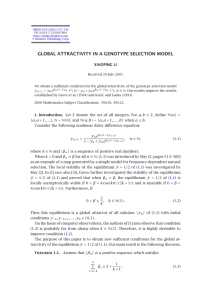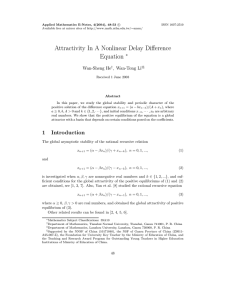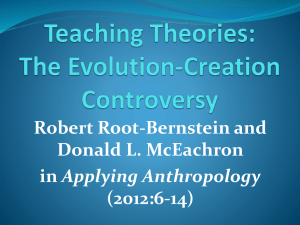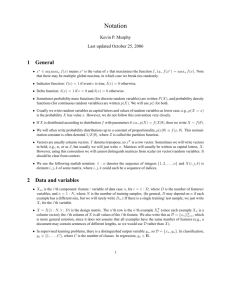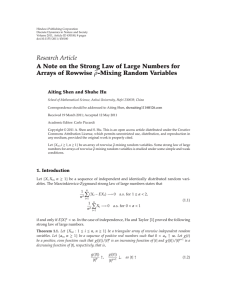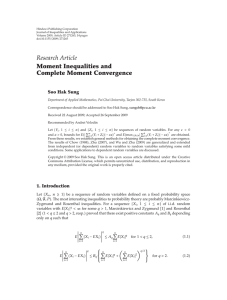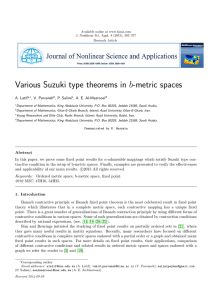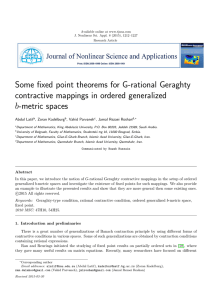Document 10677213
advertisement
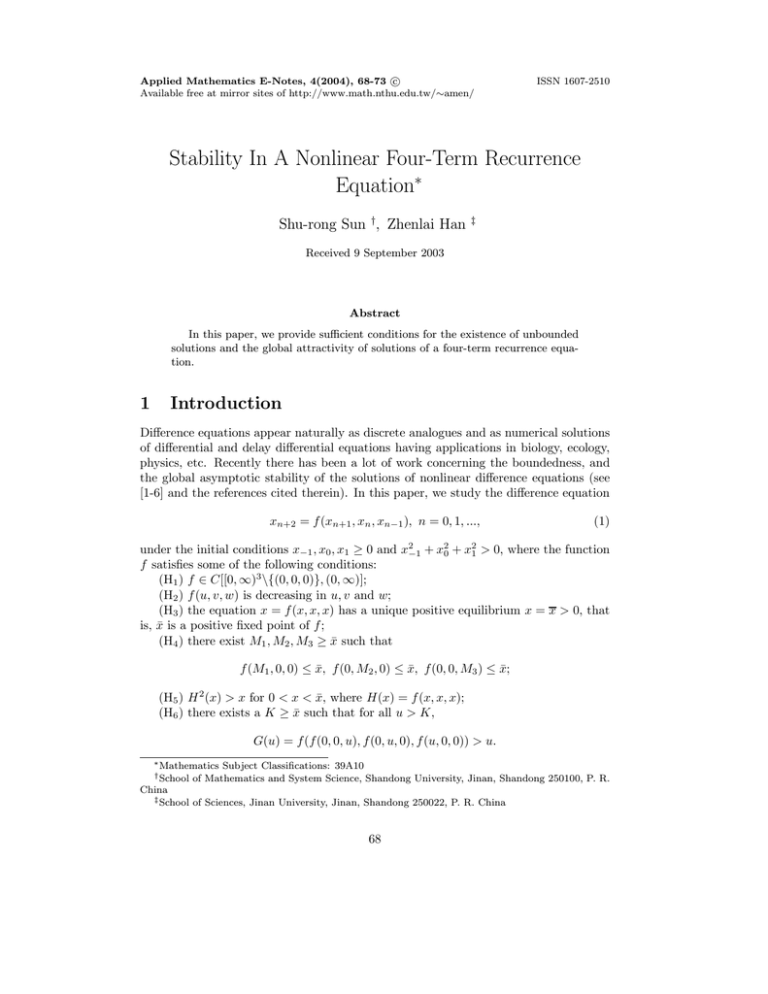
Applied Mathematics E-Notes, 4(2004), 68-73 c
Available free at mirror sites of http://www.math.nthu.edu.tw/∼amen/
ISSN 1607-2510
Stability In A Nonlinear Four-Term Recurrence
Equation∗
Shu-rong Sun †, Zhenlai Han
‡
Received 9 September 2003
Abstract
In this paper, we provide sufficient conditions for the existence of unbounded
solutions and the global attractivity of solutions of a four-term recurrence equation.
1
Introduction
Difference equations appear naturally as discrete analogues and as numerical solutions
of differential and delay differential equations having applications in biology, ecology,
physics, etc. Recently there has been a lot of work concerning the boundedness, and
the global asymptotic stability of the solutions of nonlinear difference equations (see
[1-6] and the references cited therein). In this paper, we study the difference equation
xn+2 = f (xn+1 , xn , xn−1 ), n = 0, 1, ...,
(1)
under the initial conditions x−1 , x0 , x1 ≥ 0 and x2−1 + x20 + x21 > 0, where the function
f satisfies some of the following conditions:
(H1 ) f ∈ C[[0, ∞)3 \{(0, 0, 0)}, (0, ∞)];
(H2 ) f (u, v, w) is decreasing in u, v and w;
(H3 ) the equation x = f (x, x, x) has a unique positive equilibrium x = x > 0, that
is, x̄ is a positive fixed point of f ;
(H4 ) there exist M1 , M2 , M3 ≥ x̄ such that
f (M1 , 0, 0) ≤ x̄, f (0, M2 , 0) ≤ x̄, f (0, 0, M3 ) ≤ x̄;
(H5 ) H 2 (x) > x for 0 < x < x̄, where H(x) = f (x, x, x);
(H6 ) there exists a K ≥ x̄ such that for all u > K,
G(u) = f (f (0, 0, u), f (0, u, 0), f (u, 0, 0)) > u.
∗ Mathematics
† School
Subject Classifications: 39A10
of Mathematics and System Science, Shandong University, Jinan, Shandong 250100, P. R.
China
‡ School of Sciences, Jinan University, Jinan, Shandong 250022, P. R. China
68
S. R. Sun and Z. L. Han
69
Our aim in this paper is to investigate the existence of unbounded solutions and
the attractivity of solutions of (1).
The initial conditions x−1 , x0 , x1 ≥ 0 and x2−1 + x20 + x21 > 0 determine a corresponding unique solution {xn }∞
n=−1 of (1). The set of all such solutions will be denoted
by Ω. The equilibrium x̄ of (1) is called a global attractor if every solution {xn } in Ω
satisfies limn→∞ xn = x. A real interval I is called an invariant interval for (1) if the
∞
additional conditions x−1 , x0 , x1 ∈ I imply the corresponding solution {xn }n=−1 ⊂ I.
x̄ is a global attractor for solutions of (1) originated from I if every solution in Ω under
the additional condition that x−1 , x0 , x1 ∈ I satisfies limn→∞ xn = x.
2
Existence of Unbounded Solutions
We first establish the existence of an unbounded solution of (1).
THEOREM 1. Assume that the hypotheses (H1 )-(H4 ) and (H6 ) are satisfied. Then
there exist unbounded solutions in Ω.
PROOF. Consider any solution {xn }∞
n=−1 in Ω that satisfies x1 > K > 0. Then
x2 = f (x1 , x0 , x−1 ) < f (x1 , 0, 0), x3 = f (x2 , x1 , x0 ) < f (0, x1 , 0), x4 = f (x3 , x2 , x1 ) <
f (0, 0, x1 ) and
x5 = f (x4 , x3 , x2 ) > f (f (0, x1 , 0), f (0, x1 , 0), f (x1 , 0, 0)) > x1 .
By induction, we obtain
x4k+5 > f (f (0, 0, x4k+1 ), f (0, x4k+1 , 0), f (x4k+1 , 0, 0)) > x4k+1
(2)
for k = 0, 1, 2, ... . Assume to the contrary that {x4k+1 } is bounded above. Since
{x4k+1 } is increasing, it must converge. Let
λ = lim x4k+1 .
k→∞
Since λ > K, from (H5 ), it follows that
f (f (0, 0, λ), f (0, λ, 0), f (λ, 0, 0)) > λ.
On the other hand, by letting k → ∞ in (2), we find
λ ≥ f (f (0, 0, λ), f (0, λ, 0), f (λ, 0, 0)),
which is a contradiction. The proof is complete.
EXAMPLE 1. Consider the Equation
xn+2 =
x2n+1
1
, n = 0, 1, ... .
+ x2n + x2n−1
(3)
√
1
Let M1 = M2 = M3 = 6 3, K = 3 and x̄ = √
3 . Then it is easy to show that
3
f (u, v, w) = u2 +v12 +w2 satisfies the hypotheses (H1 )-(H4 ) and (H6 ). Hence by Theorem
1, there exists a solution of (3) that is unbounded.
70
3
Four Term Recurrence Equation
Attractivity
In this section, we study the attractivity of the positive equilibrium x̄ of (1). Let
I ⊂ (0, ∞) denote the maximal interval containing x̄ such that the function h, defined
by
h(x) = f (f (x, x, x), f (x, x, x), f (x, x, x))
(4)
satisfies the weak negative feedback condition
(h(x) − x)(x − x̄) ≤ 0, x ∈ I.
Also, let a = inf I and b = sup I.
LEMMA 1. Assume that the hypotheses (H1 )-(H4 ) are satisfied. Then the following
statements are true:
(a) 0 ≤ a ≤ x̄ ≤ b ≤ ∞.
(b) If a > 0, then a ∈ I and h(a) = a.
(c) If b < ∞, then b ∈ I and h(b) = b.
(d) If either a = x̄ or b = x̄, then I = {x̄}.
(e) a > 0 if, and only if, b < ∞. If a > 0, then a = f (b, b, b) and b = f (a, a, a).
(f ) a = 0 if, and only if, b = ∞.
PROOF.
(a) This is trivial.
(b) Clearly, h(x) ≥ x for a < x ≤ x̄. Assume to the contrary that a ∈
/ I. Then
h(a) < a. Since h is continuous, there exists an > 0 such that h(x) < x for x ∈
(a − , a + ), which is a contradiction. Therefore, h(a) ≥ a. If h(a) > a, there exists an
> 0 such that h(x) > x for x ∈ (a − , a + ). So a = inf I, which is a contradiction.
Consequently, we obtain h(a) = a.
(c) Similar to (b).
(d) Let a = x̄. Assume to the contrary that b > x̄. Then for all x ∈ [x̄, c], where
x̄ < c < b, we have
f (x, x, x) ≤ f (x̄, x̄, x̄) = x̄, f (x, x, x) ≥ f (c, c, c), h(x) ≤ x.
Furthermore, f (x, x, x) ∈ [f (c, c, c), x̄] and
h(f (x, x, x)) = f (h(x), h(x), h(x)) ≥ f (x, x, x),
so that [f (c, c, c), x̄] ⊂ I, which is a contradiction. The case where b = x̄ is similarly
proved.
(e) Let 0 < a < x̄. Since f (x, x, x) is continuous and decreasing, we find
f ([a, x̄], [a, x̄], [a, x̄]) = [x̄, f (a, a, a)].
For every x ∈ [x̄, f (a, a, a)], there exists a unique x ∈ [a, x̄] such that f (x , x , x ) = x.
As a result, h(x ) ≥ x and
h(x) = h(f (x , x , x )) = f (h(x ), h(x ), h(x )) ≤ f (x , x , x ) = x,
S. R. Sun and Z. L. Han
71
which implies [x̄, f (a, a, a)] ⊂ I and f (a, a, a) ≤ b. Assume to the contrary that
f (a, a, a) < b. Let c ∈ (f (a, a, a), b). Using similar arguments as above, we find
f ([x̄, c], [x̄, c], [x̄, c]) = [f (c, c, c), x̄] ⊂ I
and
a ≤ f (c, c, c).
Since c > f (a, a, a) and h(a) = a, we find
f (c, c, c) < f (f (a, a, a), f (a, a, a), f (a, a, a)) = h(a) = a,
which is a contradiction. Therefore, b = f (a, a, a) < ∞. The case when b < ∞ is
similarly proved.
(f ) This follows from (e).
COROLLARY 1. Assume that the hypotheses (H1 )-(H4 ) are satisfied. Then I can
be {x̄}, [a, b], or (0, ∞), where 0 < a < x̄ < b < ∞, a = f (b, b, b) and b = f (a, a, a).
LEMMA 2. Assume that the hypotheses (H1 )-(H4 ) are satisfied. Then I is an
invariant interval of (1).
PROOF. If I = {x̄} or I = (0, ∞), the proof is easy. The remaining case is
when I = [a, b], where 0 < a < x̄ < b < ∞, a = f (b, b, b) and b = f (a, a, a). Let
x−1 , x0 , x1 ∈ [a, b]. Then
a = f (b, b, b) ≤ x2 = f (x1 , x0 , x−1 ) ≤ f (a, a, a) = b,
a = f (b, b, b) ≤ x3 = f (x2 , x1 , x0 ) ≤ f (a, a, a) = b,
and
a = f (b, b, b) ≤ x4 = f (x3 , x2 , x1 ) ≤ f (a, a, a) = b.
If xk−1 , xk , xk+1 ∈ [a, b], then by induction,
a = f (b, b, b) ≤ xk+2 = f (xk+1 , xk , xk−1 ) ≤ f (a, a, a) = b.
The proof is complete.
THEOREM 2. Assume that the hypotheses (H1 )-(H5 ) are satisfied. Then x̄ is a
global attractor for solutions of (1) originated from I.
PROOF. The case where I = {x̄} is trivial, so we will assume I = {x̄}. Let
x−1 , x0 , x1 ∈ I. Then the solution {xn } is bounded. So
0 < λ = lim inf xn ≤ x̄ ≤ µ = lim sup xn < ∞.
n→∞
n→∞
Clearly,
λ, µ ∈ I, h(λ) ≥ λ, h(µ) ≤ µ.
Let {xni } be a subsequence of {xn } such that
lim xni +1 = µ.
i→∞
72
Four Term Recurrence Equation
Then for every > 0, there exists an integer N0 such that xni −1 , xni , xni +1 > λ − ,
and xni +2 = f (xni +1 , xni , xni −1 ) < f (λ− , λ − , λ − ). Hence µ ≤ f (λ − , λ − , λ − )
for every > 0, which implies µ ≤ f (λ, λ, λ). Similarly, we may show that
λ ≥ f (µ, µ, µ).
In view of the fact that H 2 (x) > x for 0 < x < x̄, we have
H(µ) = f (µ, µ, µ) ≤ λ ≤ x̄ ≤ µ ≤ f (λ, λ, λ) = H(λ).
(5)
It is easy to see that λ = µ = x̄ for λ = x̄. Hence, we can assume that λ < x̄. By (5),
the properties of H(x) and (H5 ), we have
H 2 (µ) ≥ H(λ) > x̄ > λ ≥ H(µ) ≥ H 2 (λ) > λ.
This is a contradiction. Therefore, λ = x̄ and λ = µ = x̄. The proof is complete.
COROLLARY 2. Assume that the hypotheses (H1 )-(H4 ) are satisfied. Let
(h(x) − x)(x − x̄) ≤ 0, x ∈ (0, ∞),
where h is defined by (4). Then x̄ is a global attractor for Ω.
EXAMPLE 2. Consider the equation
1
, n = 0, 1, 2, ... .
xn+2 = √
√
√
xn+1 + xn + xn−1
√
√
2
3
Let M1 = M2 = M3 = 3 3 3, h(x) = H 2 (x) = 33 x 4 , f (u, v, w) = √u+√1v+√w . We
can check that the hypotheses of Theorem 2 are satisfied. Thus, x̄ is an attractor
√
3
of all solutions {xn } with initial conditions x−1 , x0 , x1 ∈ I. In fact, x̄ = 33 is a
∞
global attractor for all the solutions {xn }n=1 with initial conditions (x−1 , x0 , x1 ) ∈
[0, ∞)3 \{(0, 0, 0)}.
References
[1] V. L. Kocić and G. Ladas, Global behavior of nonlinear difference equations of
higher order with applications, Kluwer Academic, Dordrecht, 1993.
[2] R. DeVault and L. Galminas, Global stability of xn+1 = A/xpn + B/xqn−1 , J. Math.
Anal. Appl., 231(1999), 459—466.
[3] R. DeVault, G. Ladas and S. W. Schultz, Necessary and sufficient conditions for the
boundedness of xn+1 = A/xpn + B/xqn−1 , J. Difference Equations Appl., 3(1998),
259—266.
[4] R. DeVault, G. Ladas and S. W. Schultz, On the recursive sequence xn+1 =
A/xpn + B/xqn−1 , in Proceedings of Second International Conference on Difference
Equations, Gordon and Breach Science Publishers, New York, 1997, pp.125—136.
S. R. Sun and Z. L. Han
73
[5] C. G. Philos, I. K. Purnaras and Y. G. Sficas, Global attractivity in a nonlinear
difference equation, Appl. Math. Comp, 62(1994), 246—258.
[6] V. L. Kocić and D. Stutson, Global behavior of solutions of a nonlinear second
order difference equation, J. Math. Anal. Appl., 246(2000), 608—626.
